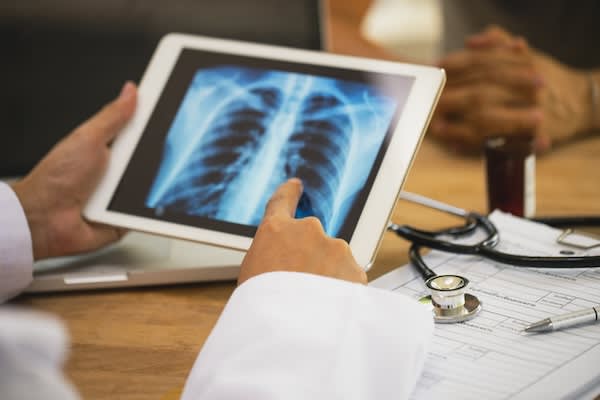Small cell lung cancer: What it is, symptoms, diagnosis and treatment

[5 MIN READ]
In this article:
-
There are two kinds of lung cancer: Small cell and non-small cell. Small cell lung cancer is considered the most aggressive type.
-
The most common symptom of small cell lung cancer is a persistent cough, although other symptoms could include chest pain and difficulty breathing.
-
It’s important that people who are at risk for lung cancer undergo annual screenings. The gold standard for screening is low-dose computed tomography (CT).
Small cell lung cancer: What it is, symptoms, diagnosis and treatment
Lung cancer is the second most common cancer in the United States, and the leading cause of cancer death. There are two main types of lung cancer — small cell lung cancer and non-small cell lung cancer.
We spoke to Richard Gillespie, M.D., a cardiothoracic surgeon and director of the Disney Family Cancer Center at Providence Saint Joseph Medical Center in Burbank, California, about why small cell lung cancer is so different from other types of lung cancer, and how it is diagnosed and treated.
What is small cell lung cancer?
Small cell lung cancer is an aggressive cancer that starts in the neuroendocrine cells that line the airway of the lungs. It gets its name from the cells themselves, which are usually small and round when viewed through a microscope.
“Lung cancer is very common, but small cell lung cancer comprises only 15% of the total lung cancer cases,” says Dr. Gillespie. “When we are determining how we will treat a specific lung cancer, we have to know what type it is, which is why a needle biopsy is so important.”
While the biggest risk factor for lung cancer is smoking, there is a certain number of non-smokers who still get lung cancer. Small cell lung cancer, however, says Dr. Gillespie, is almost exclusively a smoker’s disease.
“The reason why it’s concerning is because it grows very fast — it metastasizes quickly,” he says. “When we are monitoring it on scans, we can see very clearly that it grows more quickly than other types.”
Symptoms of small cell lung cancer
The most common small cell lung cancer symptom is a cough. “That’s a particularly hard to detect symptom,” says Dr. Gillespie, “because most people who are chronic smokers have a cough.”
Beyond a cough, other symptoms could include:
- Chest pain
- Coughing up blood
- Difficulty breathing
- Fatigue
- Hoarseness
- Loss of appetite
- Swelling in the face
- Wheezing
“Small cell lung cancer tends to be big, bulky and live more centrally in the chest,” says Dr. Gillespie. “You often have the tumors growing into the airway and the larger structures in the middle of the chest, which is why surgery is not usually possible for treatment. With the cough, you may have airway blockage that can lead to really profound shortness of breath.”
Most of the time, the later symptoms of small cell lung cancer are much like the earlier symptoms — just more severe.
How is small cell lung cancer diagnosed?
The first step in small cell lung cancer diagnosis, says Dr. Gillespie, is performing a chest X-ray, which will reveal whether there is a mass in your lungs. Then, your doctor will perform a computed tomography (CT) test, a more thorough X-ray that creates detailed cross-sectional images of your body.
The definitive test to diagnose small cell lung cancer is a biopsy — either a CT-guided biopsy or a bronchoscopy. These tests are important because your doctor will be able to test a sample of your lung tissue. “I tell my patients that truth is in the microscope,” says Dr. Gillespie. “Until you look at it under a microscope, you don’t really know what it is. In the case of small cell lung cancer, it’s clusters of very small blue cells that are very similar to each other.”
Staging for small cell lung cancer is quite different from non-small cell lung cancer. Rather than using the commonly-known stages (1, 2, 3 and 4), your doctor will use one of two stages:
- Limited stage means the cancer is all in one area
- Extensive stage means the lung cancer has spread to several different places
“Typically, in order to stage the cancer, we will order both a positron emission tomography (PET) scan and a brain magnetic resonance imaging (MRI) test,” says Dr. Gillespie.
Treatment options for small cell lung cancer
While surgery may work for some types of cancer, it is usually not an option for small cell lung cancer. Instead, doctors develop a treatment plan that includes a combination of chemotherapy and radiation therapy at the same time. But even that is usually reserved for only limited stage small cell lung cancer.
“Limited stage means you can fit the entirety of the tumor in the radiation field,” says Dr. Gillespie. “For people who have extensive stage small cell lung cancer, we can’t radiate their entire body, so it doesn’t work as a treatment option.”
Dr Gillespie notes that when he first became a surgeon 20 years ago, small cell lung cancer was a death sentence. Now, because of new chemotherapy and immunotherapy treatments, people with small cell lung cancer have a 20% chance of surviving for more than five years.
“If you get a diagnosis, it’s a very serious thing,” he says. “You have to find a good doctor — someone you trust.”
Importance of early detection
Because small cell lung cancer can progress so quickly, it is especially important to undergo screening if you are at risk of lung cancer.
The U.S. Preventive Services Task Force recommends screening for lung cancer if you meet both of the following criteria:
- Are 50-80 years old
- Have a 20 pack-year smoking history and currently smoke or have quit within the past 15 years
The gold standard for screening is an annual low-dose CT scan. “I’m a big proponent of lung cancer screening” says Dr. Gillespie. “If we screen the appropriate population, we can reduce lung cancer death by 20%.”
If you meet the screening criteria for lung cancer, talk to your primary care provider about scheduling a lung CT scan. It could save your life.
Contributing caregivers

Richard Gillespie, M.D., is a cardiothoracic surgeon and director of the Disney Family Cancer Center at Providence Saint Joseph Medical Center in Burbank, California.
Find a doctor
If you are looking for a primary care provider, you can find one who’s right for you in our provider directory. Through Providence Express Care Virtual, you can access a full range of health care services.
Download the Providence app
It’s all in the app: easily stay connected with Providence and your health. With the Providence app, you can schedule appointments, have virtual visits from the comfort of your home, get personalized health recommendations, access your health records and so much more. Learn more and download the app.
Related resources
What is non-small cell lung cancer?
Innovative lung cancer treatment
Immunotherapies for GI and lung cancers
This information is not intended as a substitute for professional medical care. Always follow your health care professional’s instructions.